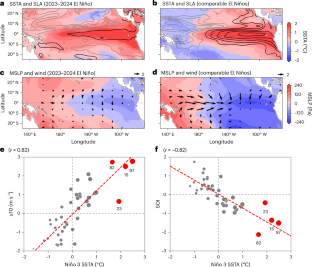2025-05-23 カリフォルニア大学サンディエゴ校(UCSD)
<関連情報>
- https://today.ucsd.edu/story/a-major-conceptual-advance-on-el-nino
- https://www.nature.com/articles/s41561-025-01700-9
海洋力学が生み出す2023~2024年の強力なエルニーニョ Strong 2023–2024 El Niño generated by ocean dynamics
Qihua Peng,Shang-Ping Xie,Ayumu Miyamoto,Clara Deser,Pengcheng Zhang & Matthew T. Luongo
Nature Geoscience Published:23 May 2025
DOI:https://doi.org/10.1038/s41561-025-01700-9

Abstract
Globally, 2023 was the hottest year on record and saw the development of a strong El Niño with widespread impacts. This El Niño event was unusual for its strong oceanic warming yet muted Southern Oscillation and wind anomalies over the tropical Pacific. This discrepancy is perplexing given the historically close coupling of El Niño and the Southern Oscillation. Atmospheric model experiments show that warming in the Atlantic and Indian Oceans in 2023 and the slow background sea surface temperature trend reduced the surface wind response over the tropical Pacific by modulating the Walker circulation. We develop a hindcast system that reproduces 87% of the June–December El Niño warming even without wind stress feedback after April 2023. The intense oceanic warming was primarily driven by the strong build-up of western Pacific heat content during the preceding prolonged La Niña. This indicates that the 2023–2024 El Niño primarily arose from oceanic processes, independent of the classic positive Bjerknes feedback mechanism. Due to the strong ocean memory, this event was highly predictable at long time leads. Climate model simulations suggest that such 2023-like El Niños may become more frequent in a warming climate.



